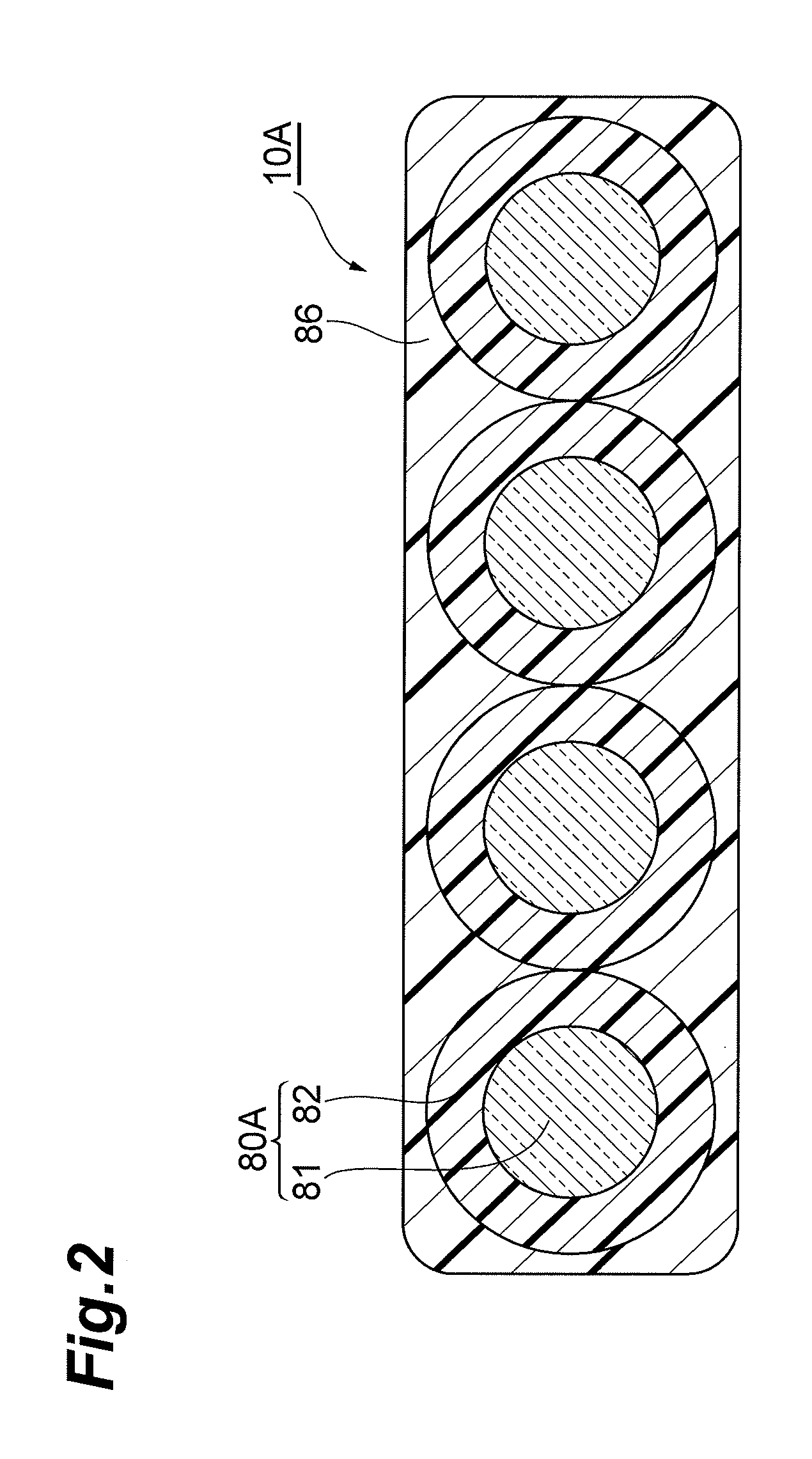Optical cable
a technology of optical fibers and optical fiber ribbons, applied in the field of optical cables, can solve the problems of increasing the transmission loss of each optical fiber, and reducing the flexibility of the optical fiber, so as to facilitate the identification of optical fibers and improve workability
- Summary
- Abstract
- Description
- Claims
- Application Information
AI Technical Summary
Benefits of technology
Problems solved by technology
Method used
Image
Examples
first embodiment
[0044]FIG. 1 is a sectional view of an optical cable 1 in accordance with the first embodiment. FIG. 1 illustrates a cross section perpendicular to the central axis of the optical cable 1. The optical cable 1 comprises an optical fiber ribbon 10, a tension member 30, and a sheath 50.
[0045]The optical fiber ribbon 10 is constructed by integrating a plurality of optical fibers 80 arranged in parallel. In general, the plurality of optical fibers 80 are an even number of optical fibers. The sheath 50 is provided so as to surround the optical fiber ribbon 10. The sheath 50 is used for protecting the optical cable 1 and constituted by a polyolefin, examples of which include PVC, PE, and EVA. One optical fiber ribbon 10 is twistably arranged within an inner space surrounded by the sheath 50.
[0046]The tension member 30 may be disposed about the optical fiber ribbon 10. The tension member 30, which is preferably fibrous, is preferably made of an aramid fiber (Kevlar (registered trademark)). ...
second embodiment
[0059]FIG. 6 is a sectional view of an optical cable 2 in accordance with the second embodiment. FIG. 6 illustrates a cross section perpendicular to the central axis of the optical cable 2. The optical cable 2 comprises a optical fiber ribbon 10, an inner tube 20, a tension member 30, an electromagnetic shield layer 40, and an sheath 50.
[0060]The optical fiber ribbon 10 is inserted in an inner space 21 of the inner tube 20 and twistable in the inner space 21. One optical fiber ribbon 10 is inserted in the inner space 21 of the inner tube 20, which is constituted by polyvinyl chloride (PVC), for example. The inner space 21 of the inner tube 20 has such a size that the optical fiber ribbon 10 is twistable therein. Preferably, the diameter of the inner space 21 of the inner tube 20 is greater than the width (in the direction in which the plurality of optical fibers are arranged) of the optical fiber ribbon 10 by at least 0.2 mm. The inner tube 20 having a thickness of 0.3 to 1 mm, for ...
third embodiment
[0065]FIG. 7 is a sectional view of an optical cable 3 in accordance with the third embodiment. FIG. 7 illustrates a cross section perpendicular to the central axis of the optical cable 3. The optical cable 3 comprises an optical fiber ribbon 10, an inner tube 20, a tension member 30, an electromagnetic shield layer 40, and a sheath 50 and, in addition, wires 61 and fillers 70. The third embodiment differs from the second embodiment in that the wires 61 and fillers 70 having the same outer diameter are disposed on the outside of the inner tube 20 but inside of the electromagnetic shield layer 40. While nine wires 61 and four fillers 70 are provided in FIG. 7, their numbers are arbitrary. All of those arranged on the outside of the inner tube 20 may be constituted by wires and no fillers. Two wires may form a pair. Each of the wires 61, which is a metal wire surrounded with an insulating coating or a coaxial electronic wire, can propagate electric signals. The tension member 30 is di...
PUM
 Login to View More
Login to View More Abstract
Description
Claims
Application Information
 Login to View More
Login to View More - R&D
- Intellectual Property
- Life Sciences
- Materials
- Tech Scout
- Unparalleled Data Quality
- Higher Quality Content
- 60% Fewer Hallucinations
Browse by: Latest US Patents, China's latest patents, Technical Efficacy Thesaurus, Application Domain, Technology Topic, Popular Technical Reports.
© 2025 PatSnap. All rights reserved.Legal|Privacy policy|Modern Slavery Act Transparency Statement|Sitemap|About US| Contact US: help@patsnap.com



